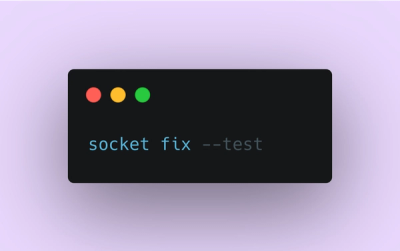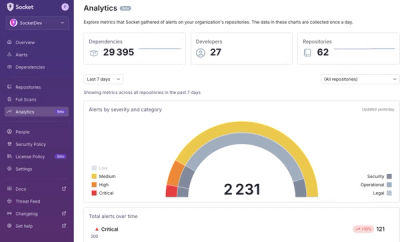
Product
Introducing Socket Fix for Safe, Automated Dependency Upgrades
Automatically fix and test dependency updates with socket fix—a new CLI tool that turns CVE alerts into safe, automated upgrades.
Supply Chain Security
Vulnerability
Quality
Maintenance
License
This is a JavaScript parser. http://github.com/qfox/ZeParser (c) Peter van der Zee http://qfox.nl
Benchmark http://qfox.github.com/ZeParser/benchmark.html
The Tokenizer is used by the parser. The parser tells the tokenizer whether the next token may be a regular expression or not. Without the parser, the tokenizer will fail if regular expression literals are used in the input.
Usage: ZeParser.parse(input);
Returns a "parse tree" which is a tree of an array of arrays with tokens (regular objects) as leafs. Meta information embedded as properties (of the arrays and the tokens).
ZeParser.createParser(input);
Returns a new ZeParser instance which has already parsed the input. Amongst others, the ZeParser instance will have the properties .tree, .wtree and .btree.
.tree is the parse tree mentioned above. .wtree ("white" tree) is a regular array with all the tokens encountered (including whitespace, line terminators and comments) .btree ("black" tree) is just like .wtree but without the whitespace, line terminators and comments. This is what the specification would call the "token stream".
I'm aware that the naming convention is a bit awkward. It's a tradeoff between short and descriptive. The streams are used quite often in the analysis.
Tokens are regular objects with several properties. Amongst them are .tokposw and .tokposw, they correspond with their own position in the .wtree and .btree.
The parser has two modes for parsing: simple and extended. Simple mode is mainly for just parsing and returning the streams and a simple parse tree. There's not so much meta information here and this mode is mainly built for speed. The other mode has everything required for Zeon to do its job. This mode is toggled by the instance property .ast, which is true by default :)
Non-factory example:
var input = "foo"; var tree = []; // this should probably be refactored away some day var tokenizer = new Tokenizer(input); // dito var parser = new ZeParser(input, tokenizer, tree); parser.parse(); // returns tree..., should never throw errors parser.tokenizer.fixValues(); // makes sure all tokens have a .value property
Highlighting example:
var parser = ZeParser.createParser(textarea.value); // textarea.value:input parser.tokenizer.fixValues(); // makes sure all tokens have a .value property var wtree = parser.tokenizer.wtree; // all the tokens ("token stream", including whitespace) textarea.className = ''; var tokenstrings = wtree.map(function(t){ if (t.name == 14) textarea.className = 'error'; return ''+(t.name==13?'\u29e6':(t.name==14?'\u292c':t.value)).replace(/&/g,'&').replace(/</g,'<').replace(/>/g,'>')+''; }); // the string that would contain highlighted code // tokenstrings.join('');
FAQs
My JavaScript parser
The npm package zeparser receives a total of 32,132 weekly downloads. As such, zeparser popularity was classified as popular.
We found that zeparser demonstrated a not healthy version release cadence and project activity because the last version was released a year ago. It has 2 open source maintainers collaborating on the project.
Did you know?

Socket for GitHub automatically highlights issues in each pull request and monitors the health of all your open source dependencies. Discover the contents of your packages and block harmful activity before you install or update your dependencies.

Product
Automatically fix and test dependency updates with socket fix—a new CLI tool that turns CVE alerts into safe, automated upgrades.

Security News
CISA denies CVE funding issues amid backlash over a new CVE foundation formed by board members, raising concerns about transparency and program governance.

Product
We’re excited to announce a powerful new capability in Socket: historical data and enhanced analytics.